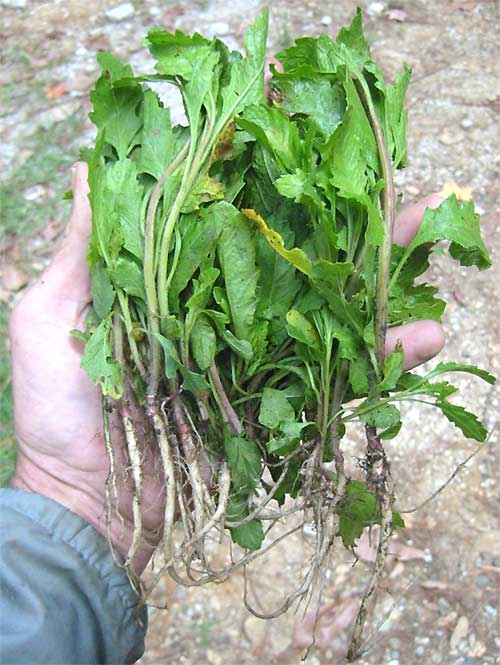Excerpts from Jim Conrad's
Naturalist Newsletter
from the January 21, 2008 issued from Yerba Buena Clinic just outside Pueblo Nuevo Solistahuacan, Chiapas, MÉXICO
about 1740 meters in elevation, ± LAT. 17° 11' 27"N, LONG. -92° 53' 35"W
EPAZOTE WORM TREATMENT
I've lost a good bit of weight since arriving here and that makes me think that maybe I have worms. In this part of the world if you want to de-worm yourself you drink Epazote tea. Epazote (eh-pa-ZO-te) is sometimes called Mexican Tea, and it grows as a weed in much of North America. It's CHENOPODIUM AMBROSIOIDES in the same family as beets and spinach, the Chenopodiaceae. When Raul, a Tzotzil-speaking friend, heard I was looking for some Epazote, the next morning he appeared at my door with a bouquet of young plants he'd just pulled from around his house, shown in my hand below:

"Tomorrow morning before breakfast put these, roots and all, into boiling water and make a tea with them. Drink the tea and wait an hour or so before eating, then drink more before going to bed, and repeat the process the next day."
When you crush Epazote leaves they emit a rank, biting odor, so I'd expected the tea to be bitter. However, it tasted like Spinach, so it wasn't bad at all. In fact, Epazote is the main seasoning in cooked beans and is believed to "remove the air from them" -- it keeps down the flatulence. Here people believe that there are at least three kinds of Epazote: One that's best for beans; another that's best for worms, and; the other is in-between. Since it's such an important feature of traditional culture it's not surprising that distinct medicinal and culinary races may have been developed.
When I supped on my steaming Epazote tea it made my stomach growl and gurgle. Unfortunately I have to use a toilet where everything disappears into a black pit, so I can't confirm that the treatment worked. I'll repeat it in a few weeks, though, and maybe then I can proceed more empirically. Whatever my experience with it, it's known that Epazote contains an alkaloid called Chenopodine, which induces roundworms to release their hold on intestinal walls and pass from the body.
Maximino Martínez's classic Las Plantas Medicinales de México reports several medicinal uses of the plant beyond worm-treatment. You can make a poultice of the leaves for the chests of people suffering from asthma, it helps in digestion, using its tea as a mouthwash eases a toothache, it calms down nervousness, and can be used as a general tonic.